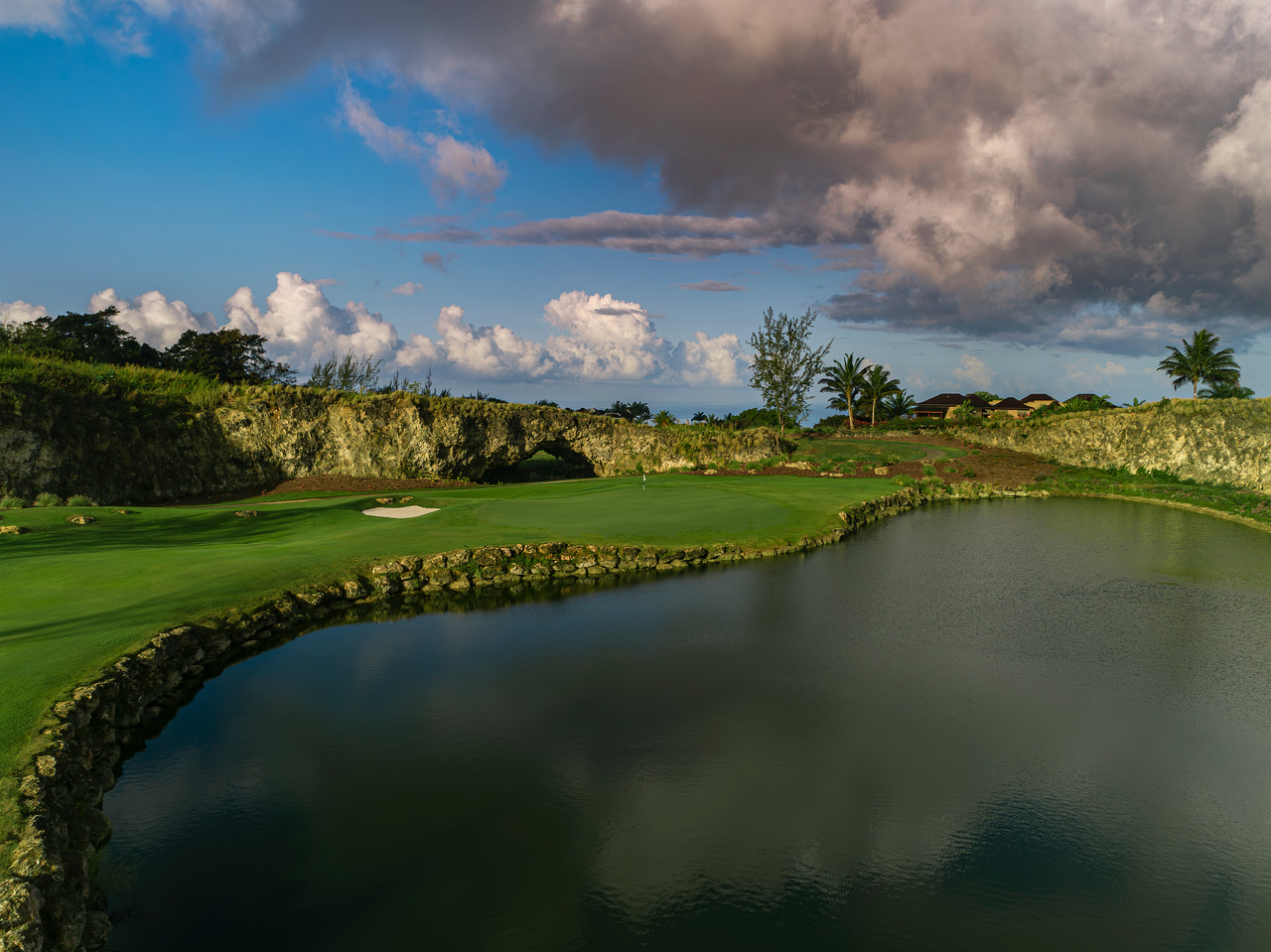I’ve been lucky enough to visit several of the island nations that make up the West Indies during the course of 30 years of adventure in the golf industry, but I’ve never had the opportunity to visit Barbados to play golf, despite it being home to two longstanding and legendary resorts in Sandy Lane and Royal Westmoreland, so when the call came in about an upcoming trip to check out a new golf development on the island I was more than delighted to clear the diary for a bit of golf under warm Caribbean skies.

HISTORY OF APES HILL
I say ‘new’, but Apes Hill, the destination for my trip, has been around since 2009, when it was built – or rather funded – by local businessman Sir Charles Williams. Sadly, the course closed in 2019, but it was subsequently bought by Canadian businessman Glen Chamandy not long after and reopened in January 2022 following a three-year hiatus and a $25m investment that has resulted in a redesigned 18-hole championship course, a new par-3 course, and an upscale property development, all of which has breathed new life into this stunning venue and given travellers another great reason to book a golf trip to this beautiful part of the world.
Flying in from Heathrow, we touched down in Bridgetown, Barbados’s historic and buzzing capital just eight hours later – the return flight is just over seven hours, making it one of the shorter ‘long haul’ journeys – and were soon making our 30-minute transfer to Apes Hill, which is located on the north eastern part of the island, which, in case you’re interested, is just 22 miles long and 12 miles across at its widest point.

ARRIVING AT APES HILL
Disembarking from the cool climate of our air-conditioned car, I was immediately hit by the warm night air, which is was a welcome feeling when compared to the UK, where opportunities to sit outside after dark without wearing several layers are few and far between.
Situated some 1,000 feet above sea level, Apes Hill is the most elevated golf course and residential community in Barbados, in fact it’s just 3km from the highest point on the island – Mount Hillaby. The altitude means that the resort offers superb views out towards both the east and west coasts and also enjoys the cooling breezes for which the island is well known.
LUXURY ACCOMMODATION
The accommodation for the duration of our stay was one of the collection of luxury villas that are dotted around the estate. Offering 3-4 bedrooms and boasting all the high-spec fittings that you’d expect, the villas offer a seamless transition from inside to out, with open-plan living areas leading out through bi-fold doors to spacious terraces and private swimming pools. Most of the properties on the estate are privately owned, but some have been kept in reserve for visiting guests. Our Villa looked over the 18th fairway. Golf membership comes as part of the package when buying a villa – which is a nice bonus.
Each villa also comes with its own private golf buggy, so after dropping my bags off, I jumped into the buggy and drove the few hundred yards or so to the 20th Hole Restaurant for dinner – which makes a change from the 19th, but we’ll come to the reason for that later.
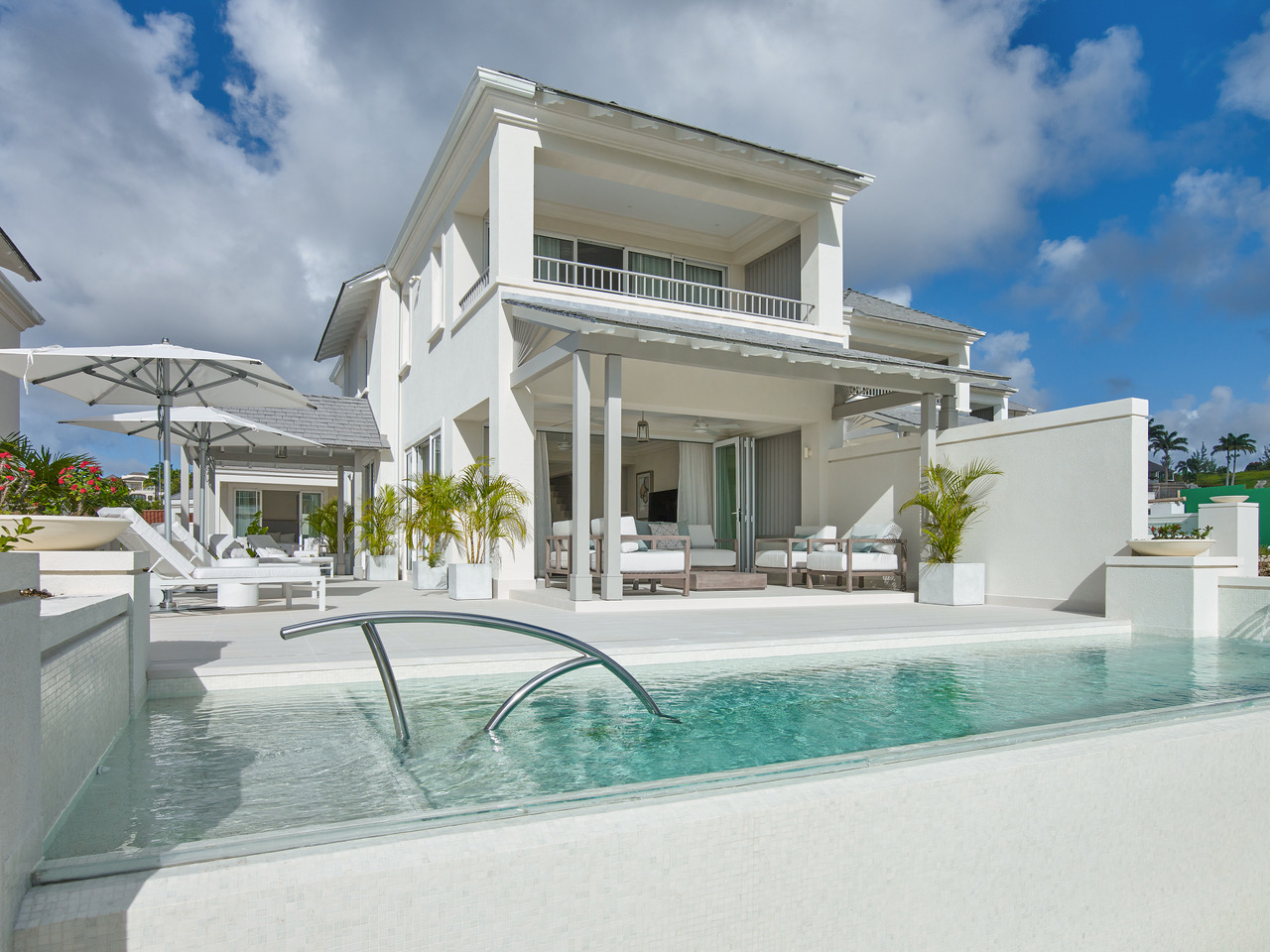
COURSE DESIGNER
The next day, after a leisurely breakfast, we played the newly renovated Apes Hill Championship Course which was redesigned by renowned American architect Ron Kirby, who sadly died this summer and for whom this was one his last design projects. It’s certainly a fitting legacy for a lifetime dedicated to creating great golf courses, as the course stays with you long after the final putt has been sunk.
Offering breath-taking views, the 7,041-yard layout sits on 450 acres of what was once a sugar plantation and plays through lush, jungle-like forests, past incredible rock formations, over water hazards and vast bunker complexes. Each of the two nines opens with uphill par fours that play into the prevailing wind and both close with downhill, downwind holes that provide a strong finish whichever way around you play the course.
THE COURSE
The front nine delivers a strong test with a selection of interesting holes, but the layout really comes into its own on the back nine, particularly the section referred to as Apes Hill’s ‘Amen Corner’. The 12th is a stunning downhill par-3 of over 200
ards, then the 13th is a majestic par-4 on which you drive between towering Bearded Fig trees on the left and a jutting rock formation on the right. With the wind out of the left, it’s a daunting tee shot. On the 14th, the hole curves from right to left and is played between huge palm trees.
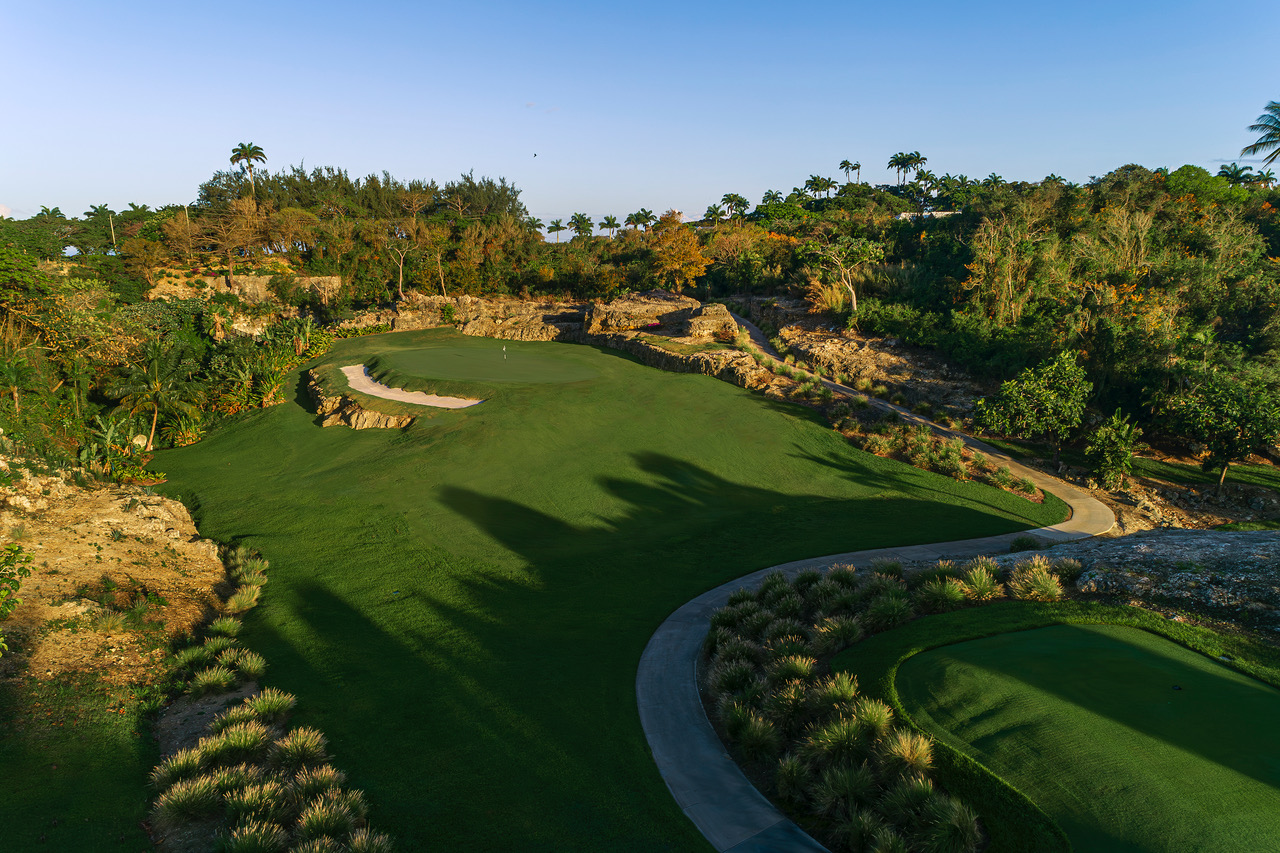
The par threes are about as good a collection of short holes as you’re likely to find in the Caribbean, with the most photogenic being the 185-yard fifth, which is cut into the side of a stone cliff whose impressive rock formation also serves as the backdrop to the equally excellent 200-yard 16th hole.
Although I had no experience of the original course, one member told me that the redesign made it much more playable than the old, which he described as being like ‘the US Open on the fourth day after a USGA official got out of the wrong side of bed’ – so we have a lot to thank Ron Kirby for, as although I found it challenging, it was great fun to play and required plenty of imagination to tackle the inclines, as well as the ever-present wind, while I recorded using every club in my bag – always the sign of a great all- round test.
FIT FOR A MAJOR CHAMPION
At this point I should add that our Apes Hill experience was also enhanced by the appearance of former world no.1 Ian Woosnam. The 1991 Masters champion and 2002 Ryder Cup captain has divided his time between Barbados and Jersey for over 25 years now and his passion for the game still burns brightly at the age of 66. An ambassador for the resort, Woosie uses Apes Hill to practice between Legends Tour events and his ball striking ability and touch with the putter seemed just as good as when he was winning all those events on tour. Still also pretty useful with a driver in hand, he shot 69 off the back tees without appearing to break sweat. He’s also great company and a tremendous gossip, sharing many an eyebrow-raising story, none of which can be repeated at this juncture – and he even generously invited us back to his house after a round at Royal Westmoreland – where he has a house – for more scurrilous golf chat!

OFF THE COURSE
One of the standout features of Apes Hill is its immaculate maintenance. The course management team, led by head superintendent Ed Paskins, spares no effort in ensuring that the course is in pristine condition year-round. From perfectly manicured fairways to fast and true greens, every detail is meticulously attended to. Sustainability is also high on the agenda at Apes Hill and one of the things they’re rightly proud of is the fact that all the irrigation for the championship course, the soon-to-open Baby Apes par-3 course, and the practice facilities, comes from the estate’s own reservoir. The development has also implemented other eco-friendly practices such as solar energy utilisation and native landscaping to minimize its ecological footprint.
In addition to the golf course, Apes Hill also boasts a state-of-the-art performance centre, where, with the expert help of the club’s Director of Golf Jody Addison and his team PGA qualified professionals, you can take advantage of all the latest coaching technology to improve your swing and your putting stroke.
THE FUTURE OF APES HILL
The clubhouse, construction of which was well underway during our visit, is a traditional Barbadian style which, judging by the rest of the estate, will extend the welcoming atmosphere shown from the minute you arrive. Inside, players will be able to relax in the comfortable lounge area, enjoy a delicious meal at the restaurant, or browse the well-stocked pro shop for the latest golfing gear.
Beyond the golf facilities, Apes Hill will shortly also boast a high-tech fitness centre, tennis courts and a swimming pool, providing further opportunities for recreation and relaxation.
Apes Hill is pretty special but it’s by no means the only golfing option on Barbados. That’s what makes this small island such a great place for golfers – Just down the road you have Royal Westmoreland as well as Sandy Lane. We had a chance to play at Royal Westmorelandand it’s another excellent layout. Designed by Robert Trent Jones Jnr, it’s more established than Apes Hill. It’s perhaps not as dramatic as its more elevated neighbour, but it still offers a highly enjoyable playing experience and there are some excellent holes to negotiate throughout the round, culminating in the fascinating downhill 18th.
CRICKET LEGENDS AT BRIDGETOWN
In between golf and a succession of memorable meals, we had a chance to check out what else the island has to offer, including a memorable evening spent at the Kensington Oval in Bridgetown watching a cricket match under the floodlights between Barbados Royals and St Kitts & Nevis Patriots
in the Caribbean Premier League. As a keen cricketer, and having watched many first-class matches back home in England, this was a truly unforgettable experience, enhanced by the lively atmosphere that surrounds all levels of cricket in the Caribbean and, if you don’t mind the name dropping, the chance to briefly meet the legend that is Sir Gary Sobers, while watching Barbados Royals star player Rahkeem Cornwall smash a 45-ball century to see the home side successfully chase down a very respectable 221 set by St Kitts & Nevis.
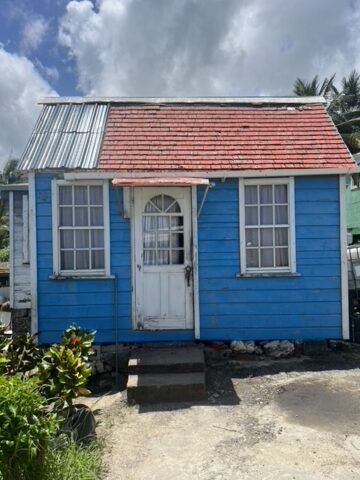
SAMPLING LOCAL LIFE
On our final day we enjoyed a guided tour of the island, which included a fascinating tour of the local Scotland district around Apes Hill, and Bathsheba, a beautiful seaside town located on the wilder east coast, while a visit to a local rum shop is a must for anyone with a taste for one of the Caribbean’s finest exports.
We rounded off the trip with a final nine holes on the Apes Hill championship course, before taking on the 19th hole, a par-3 island green decider for any match that finds itself level after 18. We were joined here by our now close friend Woosie for one last hurrah, and of course, one last post-match beer.
IAN WOOSNAM’S FAVOURITE HOLES AT APES HILL
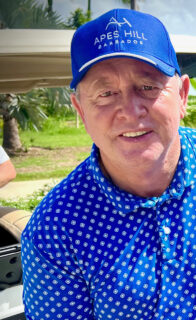
5TH, PAR 3, 165 YARDS
This is a gorgeous little par 3 which exposes the natural coral rock. It can be any club depending on the wind, so don’t be afraid to club up if necessary!
12TH, PAR 3, 215 YARDS
After the 16th, the 12th is the most demanding of the short holes. I often go in here with a mid to long iron, The configuration of the green also allows for some tricky pin positions, further ramping up the challenge.
13TH, PAR 4, 420 YARDS
The elevated tee shot on this hole gives you the feeling that its there for the taking, but anything but a long, straight drive will put you in trouble, with the rocks around the side of the green and the bunker demand a very accurate approach shot.
16TH, PAR 3, 170 YARDS
This is a great short hole that delivers an amphitheatre-style feel. It’s a proper ‘do or die’ tee shot with an incredible backdrop of the cave. It measures 200 yards from the championship back tee and those with nerves of steel should play it from there
FOR FURTHER INFORMATION VISIT: APESHILL.COM
10 THINGS ABOUT BARBADOS
Barbados is named after a tree. When the Portuguese first discovered the island in 1536 the Bearded Fig Tree was found all over the island. “Los Barbados” is Portuguese for “The Bearded One.”
It is known for its exquisite local cuisine and world renowned chefs, making it the Culinary Capital of the Caribbean
The people of Barbados are officially called Barbadians, but more commonly known as Bajans
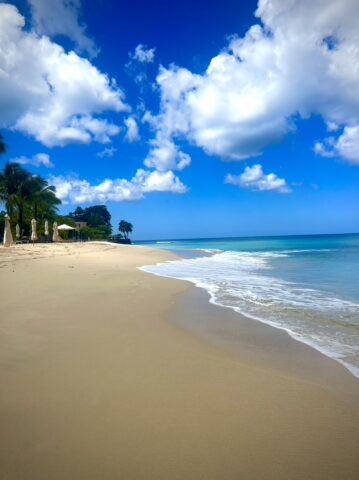
The island has an average temperture of 28 degrees all year round
Barbados is the 13th smallest country in the world
The island’s capital city Bridgetown is a UNESCO World Hertige Site
Barbados has over 60 white sandy beaches along its 80-mile coastline, many of which are named the most beautiful in the Caribbean
Barbados is the birthplace of billionaire superstar Rihanna. Barbados named the street that Rihanna grew up on after her – ‘Rihanna Drive
Their national flag is full of symbolism. The ultramarine blue represents the ocean and sky, and the gold-yellow panel represents the sandy beaches of the island. The broken trident represents the country breaking free from its status as a colony.
Barbados is the birthplace of rum and home to Mount Gay Rum. Mount Gay Rum is the oldest rum brand in the world dating back to 1703. Today the rum is exported to 110 countries in the world. Tours of the distillery, followed by a rum tasting, are available to book online.



